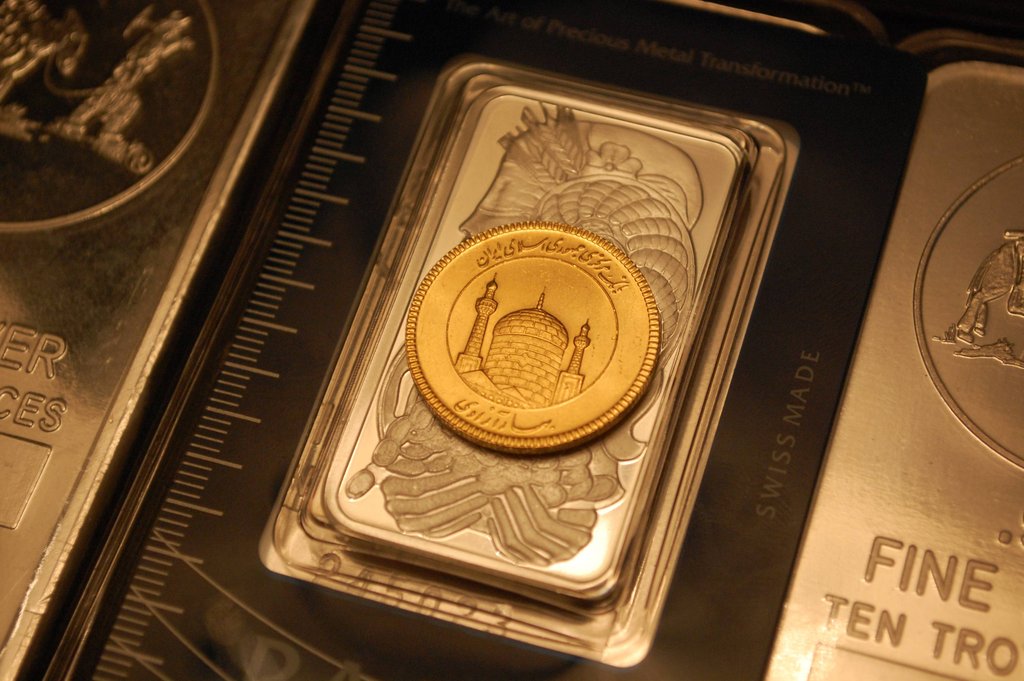Benchmark bullion coin, the Azadi, had a rough trading week. It ended the Iranian week lower on account of a sharp drop on Saturday (Feb. 7), as international price fluctuations and Iran’s foreign affairs swayed its price.
A two percent drop in gold spot prices on Friday, prompted the Azadi to open 1.88 percent lower than the prior week’s close on Saturday followed by a series of events which sent the bullion coin up and down the board.
The precious coin spent the rest of the week recouping some of its losses, ending the week 0.3 percent lower than its open and 2.1 percent lower than last week’s close.
Last week was the third consecutive week of losses for Azadi. The gold coin has lost 5.5 percent during the Iranian month of Bahman, which started on Jan. 21.
Saturday’s Drop
The bullion coin fell to a four-week low of 9,720,000 rials at the beginning of the week, prompted by gold’s fall on Friday’s close in the international markets and optimism about Iran’s nuclear talks following Friday’s meeting between US Secretary of State John Kerry and Iranian Foreign Minister Mohammad Javad Zarif.
Azadi sank 2.24 percent on Saturday, breaking bellow the 10,000,000 rials mark, for the first time since Jan. 15, following gold’s drop in the international markets on Friday as US economic data beat expectations, changing the outlook on US interest rates. It was further pressured on Sunday’s open when it hit the four-week low.
Gold fell more than two percent on Friday as global stock markets and the dollar rose on stronger-than-expected US jobs data, raising expectations that the Federal Reserve will increase interest rates by midyear, Reuters reported.
US nonfarm payrolls increased by 257,000 last month, topping expectations for 234,000, with the unemployment rate ticking up to 5.7 percent due to more people entering the labor force.
Monday’s Recovery
The gold coin which had its worse losing streak in 12 months on Saturday and Sunday morning, recovered some lost ground on Monday, as lower prices prompted some traders to go long on the precious coin.
“The Azadi’s slide on Saturday was partly owed to the dollar’s fall,” said a veteran currency trader in Fredowsi Street – Tehran’s center of currency trade – to Financial Tribune, “everyone got optimistic about the nuclear talks, after foreign ministers Zarif and Kerry met in Munich, and now the fervor has subsided.”
Strong demand for Azadi sent the coin to its week’s high of 9,980,000 rials on Monday evening, just shy of the key 10,000,000 rials level, a strong psychological price level for the Azadi. Nonetheless the gold coin couldn’t hold on to its gains that day and fell to 9,910,000 rials by the session’s close, up 0.5 percent for the day.
Azadi’s Monday gains were also backed by a rebound in the US dollar’s value versus the rial due to fading optimism about the Iran, P5+1 talks, and renewed demand for the precious metal in the international markets on Monday’s open in Asia. The P5+1 constitute of the five permanent members of the UN Security Council – the US, Britain, France, Russia and China – plus Germany.
Gold edged higher on Monday, as Asian equity markets fell data on Sunday showed China’s trade performance slumped in January, with exports falling 3.3 percent from year-ago levels, while imports tumbled 19.9 percent, far worse than analysts had expected and highlighting deepening weakness in the Chinese economy, Reuters reported. This backed Azadi’s rebound on Monday.
The rest of the week’s trading was disrupted by the holiday for the celebration of Iran’s 1979 Islamic Revolution on Feb. 11, with trading volume falling markedly. Azadi edged lower than the week’s high on Tuesday but went up on Thursday, closing at 9,870,000 rials by Thursday evening.
Iran and the six world powers are negotiating over the scope of Iran’s nuclear energy program and the sanctions imposed on Tehran. The two sides have set themselves a March deadline to reach a political agreement ahead of a final nuclear deal by June 30. The agreement would be on limiting Iran’s nuclear program in exchange for lifting sanctions. Iran and the six have twice extended the negotiations after failing to meet previous deadlines for a permanent deal.



